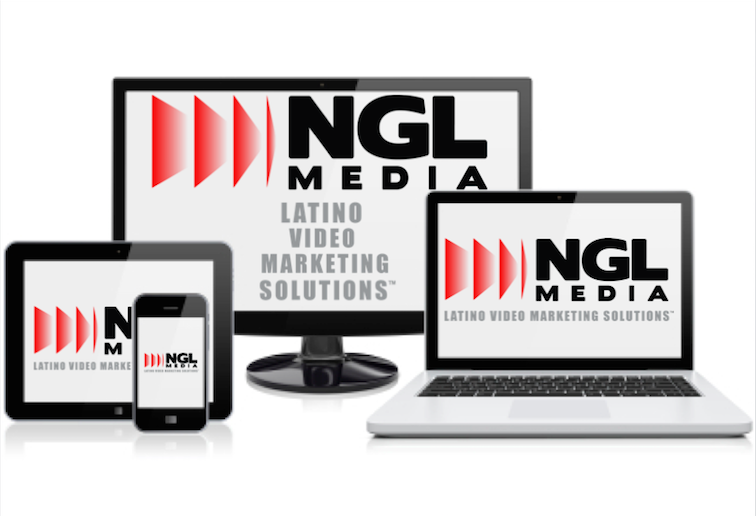Presented By NGL Media
A comprehensive roadmap to discovering U.S. Hispanic programmatic video provided by leading Latino video marketing solutions company, NGL Media. Catch NGL Media‘s CEO & Founder, David Chitel, who spoke last week at Portada’s 11th Annual Multicultural Marketing & Media Conference.
The digital video landscape provides amazing opportunities for advertisers to connect with U.S. Hispanics across paid, owned and earned media. Be it branded entertainment, social influencer campaigns, managed media buys or programmatic, the choices are many.
According to the latest IAB Ad Spend Study, 69% of digital video ad spending — or nearly US$6 billion dollars — will be allocated programmatically this year alone. U.S. Hispanic programmatic video spending has been growing in tandem.
Yet navigating the Hispanic online space can be challenging, given that the publisher landscape is extremely fragmented by different cultural identities and countries of origin. Programmatic is a particularly useful strategy to reach the U.S. Latino market at scale by facilitating access to this fragmented audience across many outlets simultaneously.
 As a premiere supplier of U.S. Hispanic programmatic video, NGL Media has been blazing a trail in the space with an offering of 300+ premium publisher partners. For those who are ready to jump into the U.S. Hispanic programmatic world, we’re happy to share some best practices.
As a premiere supplier of U.S. Hispanic programmatic video, NGL Media has been blazing a trail in the space with an offering of 300+ premium publisher partners. For those who are ready to jump into the U.S. Hispanic programmatic world, we’re happy to share some best practices.
1. Understand Open Marketplace vs. Private Marketplace vs. Programmatic Direct
All programmatic is bought via DSPs and the majority through trading desks — essentially buying arms of agencies. Three basic types of programmatic deals currently dominate the field: open marketplace, private marketplace and programmatic direct.
The open marketplace is a virtual auction. Using software, buyers place bids on billions of ad impressions made available on the ad exchange. For buyers and sellers, the process can feel chaotic. For brands seeking a more premium and transparent environment, however, private marketplaces have proven to be even more attractive.
A private market place (PMP) offers a more controlled environment. The difference between open marketplace and PMPs? With the latter, the buyer sets up a direct connection to a seller’s inventory. The buyer knows exactly what inventory they’re getting, which provides a greater level of quality assurance. The seller and buyer agree on key performance indices (KPIs) and targeting specs, working together to optimize for performance and scale. A PMP brings full transparency to buyers, greater publisher control, and more premium inventory at scale.
Programmatic direct agreements are automated buys that leverage programmatic platforms, but more closely resemble a managed buy albeit with certain guarantees arranged in advance. Negotiations may include premium inventory at a set price for a guaranteed set of impressions. It’s like calling a car rental company and reserving a specific make and model rather than asking for a “mid-sized auto.”
As more and more clients jump into the programmatic space, the prevailing trend is for brands to lock up inventory in the private, rather than open marketplace. This helps assure inventory demands will be met. Demand for programmatic direct deals is also growing for this same reason.
2. Choose Your SSP or DSP Partners Wisely
Supply-side platforms (SSPs) automate the SALE of advertising by using software. Demand-side platforms (DSPs) automate the BUYING of advertising by using software.
What’s the difference? Publishers and their reps use SSPs to try to maximize pricing and provide access to buyers that might otherwise not buy their properties as a standalone but will as part of a larger programmatic buy.
Brands, agencies and their representatives use DSPs to purchase the best quality inventory at the best possible price. However, perhaps even more crucial is the search for critical mass and optimization across a broad list of sites. The other important piece — perhaps the biggest in the eyes of many marketers — is that DSPs and programmatic allow you to overlay targeting data through the DSP.
Whether you’re looking for a DSP or SSP, the process can be overwhelming. The market is inundated with options. Make sure you look for a supply side platform that’s well-connected. The wider the range of associations to inventory outlets, the wider the potential ad inventory.
Other important considerations include technical support offered and the ability to optimize campaigns for frequency caps, budgets and creative. Transparency about how the DSP or SSP makes its money is another item to be mindful of.
Finally, data is the name of the game here. Look for vendors who have access to reputable data management platforms (DMPs) and allow buyers to leverage first- or third-party data sources.
3. Avoid Data-Overlay Over-Targeting
The holy grail of marketing is to find the perfect message to deliver during points along the consumer decision journey. The use of data now allows marketers to pinpoint by specific demographics, activities and interests.
Scale can be hard to find in the U.S. Hispanic marketplace, especially if you’re looking for high-quality inventory. During the planning stage, coordinate with your SSP or publisher partner to determine the viability of an upcoming campaign and to see how much data targeting will prove useful. When setting up a PMP, be sure to include in your request for proposal (RFP) a question about how much data overlay the SSP or publisher can offer while still providing the necessary scale you seek.
Remember: Each layer of data targeting filters out more consumers. Too many layers will hinder your ability to reach desired impression goals. When targeting the Hispanic market, many clients want to add multiple layers of Hispanic user data. Some even want to target by browsers set to Spanish language. Doing so can be problematic, given already limited U.S Latino online video inventory. By finding a supply partner that has already aggregated premium Hispanic specific inventory (such as NGL Media), you have the flexibility to remove overly restrictive data targeting.
4. Hold Your Supply Chain Accountable
Huge brands like P&G and Unilever are leading the charge against digital pain points. Issues like brand safety, bot fraud/invalid traffic and performance errors have filled the trade headlines as of late. Every part of the supply chain must be held accountable: from exchanges to media companies to ad tech partners.
As you’re exploring new business relationships, be sure to address the following with your supply partners:
Invalid Traffic (IVT) and other forms of fraud: Some estimates say 20-25% of all digital expenditures goes towards fraudulent inventory, or more than $15 billion. The Media Rating Council defines two types of non-human traffic. “General IVT” is relatively simple to detect, while “Sophisticated IVT” is much harder, given that it “originates from hijacked devices, malware or misappropriated content.”
Keep in mind that some bot traffic is legit. Google runs legitimate bots across the Internet to obtain information. Most agree that some level of IVT is to be expected given all of the converging technologies that often don’t perfectly line up. Moreover, advertisers seeking 0% is less practical in today’s evolving digital environment.
Use third-party vendors to measure IVT, such as MOAT, Integral Ad Science (IAS), DoubleVerify (DV) and White Ops.
Viewability: Standards vary by company, agency and even campaign. The Internet Advertising Bureau (IAB) defines viewability as 50% of the video must be in view for two seconds or longer.
Others have set the bar higher, requiring 100 percent of pixels be in view with the sound on for half the duration of the video. Native and outstream video in some cases are allowed to play with or without the sound, and be auto-played or user-initiated.
Talk about this metric and make sure every partner in the supply-chain is clear about the client’s expectations. Define how viewability will be measured. Will it be with a third-party vendor like DV or MOAT? How will the metric be reported back to the programmatic platform?
Measurement technologies are not perfect, so if you’re requesting guarantees against viewability performance, expect to pay a higher cost per thousand (CPM).
Brand Safety: It’s always been important for clients to know their advertising is supporting content free of hate, pornography, strong language, gratuitous violence, etc.
Use a brand safety technology like IAS or DV to avoid non-safe brand sites, but also strive for transparency with your supply partner. Strike a balance.
Technology might flag an article about parenting on a premium site that mentions “breast feeding” because of the word “breast,” causing that site to be listed as inappropriate and thus blocked. Watch the blocked list, and then use common sense to determine if publishers were blocked for good reason — or because of the limitations of the technology.
Financial transparency: Clients should be able to see where their dollars are going and how well the campaign is going. Programmatic trade can help increase transparency for every impression.
5. People Still Matter
Find a partner with the resources, experience and drive to continuously update its technology. Like every area in the modern world, the pace of change is brutal. Just to keep pace with the competition, companies must innovate. Make sure you choose a partner that understands and anticipates market changes. At NGL Media, we’ve heavily invested in our proprietary video technology stack, which allows us to be nimble and agile in an ever-changing digital market.
A programmatic deal should be a true partnership between buyer and seller, especially when running PMPs. It’s easy to set up the software and let the machines run on autopilot, only interacting with the technology platforms, rather than other humans. But communication between buyer and seller is key to making sure the systems work smoothly and the campaign achieves the desired scale. People often make all the difference between a successful and an unsuccessful programmatic video advertising campaign.
[ctahcb]







